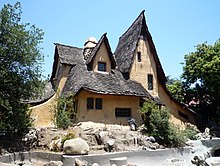Harry Oliver (production designer)
Harry G. Oliver (born April 4, 1888 in Hastings , Minnesota - † July 5, 1973 in Woodland Hills , Los Angeles , California ) was an American art director , production designer , architect and designer .
Life

Oliver began his career in 1919 as an art director and production designer for silent films and first worked on The Face of the World (1919).
After Ben Hur (1925) he was nominated at the first Academy Awards in 1929 for the Oscar in the category of best production design in the film Das Glück in der Mansarde (1927) by Frank Borzage . At the following Academy Awards in April 1930 he was nominated again for an Oscar for his set design in the film Engel der Straße (1928), also made by Borzage .
He also created the set design for numerous other films, including The First Woman in the Life of Frank Borzage, City Girl (Our Daily Bread - The Woman from Chicago, 1930) by Friedrich Wilhelm Murnau , Film Crazy (1932) by Clyde Bruckman with Harold Lloyd and Scream of the Haunted (1934) by Jack Conway , Howard Hawks, and William A. Wellman .
Oliver also worked as a designer and created the windmill buildings for the American bakery chain van de Kamp . In addition, he created as an architect building in the so-called Storybook House style, one in 1920 years ago in England popular and the US architectural style . One of his most famous buildings is the Spadena House in Beverly Hills from 1921, which is also called The Witch's House . This was also used again and again as a film set like in 1995 in Clueless - What else! .
Filmography (selection)
- 1927: Luck in the attic (Seventh Heaven Heaven7th)
- 1928: Street Angel (Street Angel)
- 1929: The First Woman in Life (The River)
- 1930: City Girl
- 1932: Movie Crazy (Movie Crazy)
- 1934: cry of the harried (Viva Villa!)
- 1934: Harold Lloyd, the straw man (The Cat's Paw)
- 1937: Make a Wish
Web links
- Harry Oliver in the Internet Movie Database (English)
| personal data | |
|---|---|
| SURNAME | Oliver, Harry |
| ALTERNATIVE NAMES | Oliver, Harry G. |
| BRIEF DESCRIPTION | American art director, production designer, architect and designer |
| DATE OF BIRTH | April 4, 1888 |
| PLACE OF BIRTH | Hastings , Minnesota |
| DATE OF DEATH | 5th July 1973 |
| Place of death | Woodland Hills , Los Angeles , California |